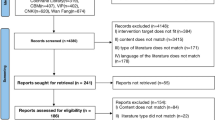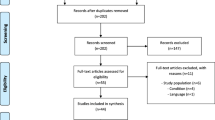Abstract
Introduction and hypothesis
Urinary incontinence (UI) is one of the most serious problems during pregnancy and after delivery. It can influence the quality of life and cause psychological problems that lead to depression and decreased self-esteem. We aimed to investigate the maternal, obstetrical and neonatal risk factors of urinary incontinence 3 to 12 months after childbirth.
Methods
The Cochrane Library, Medline, Science Direct and Web of Science were searched for studies published from the inception of the databases up to December 2019, including any observational full-text papers. All data were analyzed using Review Manager 5.3. Of 338 articles reviewed, 20 studies were considered for meta-analysis.
Results
The results of our study showed that vaginal delivery in contrast to cesarean section (OR = 3.74, 95% CI: [2.71, 5.15], P < 0.00001), UI in pregnancy (OR = 5.27, 95% CI: [3.40, 8.17], P < 0.00001), episiotomy (OR = 1.23, 95% CI: [1.05, 1.45], P < 0.01), perineal tear > grade 2, instrumental delivery in contrast to cesarean section, epidural or spinal anesthesia, maternal age, pre-pregnancy BMI and neonatal birthweight have a direct relationship with UI.
Conclusions
This study confirmed that urinary incontinence during pregnancy and vaginal births had the strongest relationship with postpartum urinary incontinence. Also, the maternal upright positions during labor did not reduce the likelihood of urinary incontinence. The awareness of this issue helps find effective strategies to reduce the likelihood of female urinary incontinence.










Similar content being viewed by others

Availability of data and material
The datasets generated during and/or analyzed during the current study are available from the corresponding author.
References
Abrams P, Cardozo L, Fall M, Griffiths D, Rosier P, Ulmsten U, et al. The standardisation of terminology of lower urinary tract function: report from the Standardisation Sub-committee of the International Continence Society. Neurourol Urodyn. 2002;21(2):167–78.
Macmillan AK, Merrie AE, Marshall RJ, Parry BR. The prevalence of fecal incontinence in community-dwelling adults: a systematic review of the literature. Dis Colon Rectum. 2004;47(9):1341–9.
Hannestad YS, Rortveit G, Sandvik H, Hunskaar S. A community-based epidemiological survey of female urinary incontinence: The Norwegian EPINCONT Study. J Clin Epidemiol. 2000;53(11):1150–7.
Irwin DE, Kopp ZS, Agatep B, Milsom I, Abrams P. Worldwide prevalence estimates of lower urinary tract symptoms, overactive bladder, urinary incontinence and bladder outlet obstruction. BJU Int. 2011;108(7):1132–8.
Milsom I, Altman D, Cartwright R, Lapitan M, Nelson R, Sillén U, et al. Epidemiology of urinary incontinence (UI) and other lower urinary tract symptoms (LUTS), pelvic organ prolapse (POP) and anal incontinence (AI). Incontinence: 5th International Consultation on Incontinence, Paris, February 2012: ICUD-EAU; 2013. p. 15-107.
Martin-Martin S, Pascual-Fernandez A, Alvarez-Colomo C, Calvo-Gonzalez R, Muñoz-Moreno M, Cortiñas-Gonzalez JR, et al. Urinary incontinence during pregnancy and postpartum. Associated risk factors and influence of pelvic floor exercises. Arch Esp Urol. 2014;67(4):323–30.
Goldberg R, Kwon C, Gandhi S, Atkuru L, Sand P. Urinary incontinence after multiple gestation and delivery: impact on quality of life. Int Urogynecol J. 2005;16(5):334–6.
Cerruto MA, D’Elia C, Aloisi A, Fabrello M, Artibani W. Prevalence, incidence and obstetric factors’ impact on female urinary incontinence in Europe: a systematic review. Urol Int. 2013;90(1):1–9.
Thorp JM Jr, Norton PA, Wall LL, Kuller JA, Eucker B, Wells E. Urinary incontinence in pregnancy and the puerperium: a prospective study. Am J Obstet Gynecol. 1999;181(2):266–73.
Arrue M, Ibañez L, Paredes J, Murgiondo A, Belar M, Sarasqueta C, et al. Stress urinary incontinence six months after first vaginal delivery. Eur J Obstet Gynecol Reprod Biol. 2010;150(2):210–4.
Diez-Itza I, Arrue M, Ibañez L, Murgiondo A, Paredes J, Sarasqueta C. Factors involved in stress urinary incontinence 1 year after first delivery. Int Urogynecol J. 2010;21(4):439–45.
Haylen BT, de Ridder D, Freeman RM, Swift SE, Berghmans B, Lee J, et al. An International Urogynecological Association (IUGA)/International Continence Society (ICS) joint report on the terminology for female pelvic floor dysfunction. Neurourol Urodyn. 2009;21:5–26.
National Collaborating Centre for Women's and Children's Health. Urinary incontinence in women: the management of urinary incontinence in women. 2013.
Sievert KD, Amend B, Toomey PA, Robinson D, Milsom I, Koelbl H, et al. Can we prevent incontinence?: ICI-RS 2011. Neurourol Urodyn. 2012;31(3):390–9.
Solans-Domènech M, Sánchez E, Espuña-Pons M. Urinary and anal incontinence during pregnancy and postpartum: incidence, severity, and risk factors. Obstet Gynecol. 2010;115(3):618–28.
Thom DH, Rortveit G. Prevalence of postpartum urinary incontinence: a systematic review. Acta Obstet Gynecol Scand. 2010;89(12):1511–22.
Sangsawang B. Risk factors for the development of stress urinary incontinence during pregnancy in primigravidae: a review of the literature. Eur J Obstet Gynecol Reprod Biol. 2014;178:27–34.
Wesnes SL, Hunskår S, Bo K, Rortveit G. The effect of urinary incontinence status during pregnancy and delivery mode on incontinence postpartum. A cohort study. BJOG Int J Obstet Gynaecol. 2009;116(5):700–7.
Altman D, Ekström Å, Gustafsson C, López A, Falconer C, Zetterström J. Risk of urinary incontinence after childbirth: a 10-year prospective cohort study. Obstet Gynecol. 2006;108(4):873–8.
Ewings P, Spencer S, Marsh H, O'Sullivan M. Obstetric risk factors for urinary incontinence and preventative pelvic floor exercises: cohort study and nested randomized controlled trial. J Obstet Gynaecol. 2005;25(6):558–64.
Mallah F, Tasbihi P, Navali N, Azadi A. Urinary incontinence during pregnancy and postpartum incidence, severity and risk factors in Alzahra and Taleqani hospitals in Tabriz, Iran, 2011–2012. Int J Womens Health Reprod Sci. 2014;2(3):178–85.
Downs SH, Black N. The feasibility of creating a checklist for the assessment of the methodological quality both of randomised and non-randomised studies of health care interventions. J Epidemiol Community Health. 1998;52(6):377–84.
Kennelly J. Methodological approach to assessing the evidence. In: Reducing racial/ethnic disparities in reproductive and perinatal outcomes. Springer; 2010. p. 7–19.
Brown SJ, Gartland D, Donath S, MacArthur C. Effects of prolonged second stage, method of birth, timing of caesarean section and other obstetric risk factors on postnatal urinary incontinence: an Australian nulliparous cohort study. BJOG. 2011;118(8):991–1000.
Gartland D, Donath S, MacArthur C, Brown SJ. The onset, recurrence and associated obstetric risk factors for urinary incontinence in the first 18 months after a first birth: an Australian nulliparous cohort study. BJOG. 2012;119(11):1361–9.
Alipour Z, Eskandari N, Ebrahimi Z, Bagheri A. Prevalence of urinary and intestinal incontinence in postpartum period and its related factors. Iran J Obstet Gynecol Infertility. 2014;16:9–15.
Kokabi R, Yazdanpanah D. Effects of delivery mode and sociodemographic factors on postpartum stress urinary incontinency in primipara women: a prospective cohort study. J Chin Med Assoc. 2017;80(8):498–502.
Baydock SA, Flood C, Schulz JA, MacDonald D, Esau D, Jones S, et al. Prevalence and risk factors for urinary and fecal incontinence four months after vaginal delivery. J Obstet Gynaecol Can. 2009;31(1):36–41.
Mannion CA, Vinturache AE, McDonald SW, Tough SC. The influence of back pain and urinary incontinence on daily tasks of mothers at 12 months postpartum. PLoS ONE. 2015;10(6):e0129615-e.
Quiboeuf E, Saurel-Cubizolles MJ, Fritel X. Trends in urinary incontinence in women between 4 and 24 months postpartum in the EDEN cohort. BJOG. 2016;123(7):1222–8.
Pizzoferrato AC, Fauconnier A, Bader G, de Tayrac R, Fort J, Fritel X. Is prenatal urethral descent a risk factor for urinary incontinence during pregnancy and the postpartum period? Int Urogynecol J. 2016;27(7):1003–11.
Serati M, Di Dedda MC, Bogani G, Sorice P, Cromi A, Uccella S, et al. Position in the second stage of labour and de novo onset of post-partum urinary incontinence. Int Urogynecol J. 2016;27(2):281–6.
Serati M, Salvatore S, Khullar V, Uccella S, Bertelli E, Ghezzi F, et al. Prospective study to assess risk factors for pelvic floor dysfunction after delivery. Acta Obstet Gynecol Scand. 2008;87(3):313–8.
Ruiz de Vinaspre Hernandez R, Rubio Aranda E, Tomas Aznar C. Urinary incontinence and weight changes during pregnancy and post partum: a pending challenge. Midwifery. 2013;29(12):e123–9.
Johannessen HH, Stafne SN, Falk RS, Stordahl A, Wibe A, Morkved S. Prevalence and predictors of double incontinence 1 year after first delivery. Int Urogynecol J. 2018;29(10):1529–35.
Glazener CM, Herbison GP, MacArthur C, Lancashire R, McGee MA, Grant AM, et al. New postnatal urinary incontinence: obstetric and other risk factors in primiparae. BJOG. 2006;113(2):208–17.
Boyles S, Li H, Mori T, Osterweil P, Guise J-M. Effect of mode of delivery on the incidence of urinary incontinence in primiparous women. Obstet Gynecol. 2009;113:134–41.
Tanawattanacharoen S, Thongtawee S. Prevalence of urinary incontinence during the late third trimester and three months postpartum period in King Chulalongkorn Memorial Hospital. J Med Assoc Thai. 2013;96(2):144–9.
Chin HY, Chen MC, Liu YH, Wang KH. Postpartum urinary incontinence: a comparison of vaginal delivery, elective, and emergent cesarean section. Int Urogynecol J Pelvic Floor Dysfunct. 2006;17(6):631–5.
Ege E, Akın B, Altuntuğ K, Benli S, Arioz A. Prevalence of urinary incontinence in the 12-month postpartum period and related risk factors in Turkey. Urol Int. 2008;80:355–61.
Casey BM, Schaffer JI, Bloom SL, Heartwell SF, McIntire DD, Leveno KJ. Obstetric antecedents for postpartum pelvic floor dysfunction. Am J Obstet Gynecol. 2005;192(5):1655–62.
Eason E, Labrecque M, Marcoux S, Mondor M. Effects of carrying a pregnancy and of method of delivery on urinary incontinence: a prospective cohort study. BMC Pregnancy Childbirth. 2004;4:4.
Hatem M, Pasquier J-C, Fraser W, Lepire E. Factors associated with postpartum urinary/anal incontinence in primiparous women in Quebec. J Obstet Gynaecol Can. 2007;29(3):232–9.
Hvidman L, Foldspang A, Mommsen S, Nielsen JB. Postpartum urinary incontinence. Acta Obstet Gynecol Scand. 2003;82(6):556–63.
Torrisi G, Minini G, Bernasconi F, Perrone A, Trezza G, Guardabasso V, et al. A prospective study of pelvic floor dysfunctions related to delivery. Eur J Obstet Gynecol Reprod Biol. 2012;160(1):110–5.
Ruiz RVH, Rubio EA, Tomás CA. Urinary incontinence 6 months after childbirth. Med Clin. 2013;141(4):145–51.
Burgio KL, Zyczynski H, Locher JL, Richter HE, Redden DT, Wright KC. Urinary incontinence in the 12-month postpartum period. Obstet Gynecol. 2003;102(6):1291–8.
Arrue M, Diez-Itza I, Ibanez L, Paredes J, Murgiondo A, Sarasqueta C. Factors involved in the persistence of stress urinary incontinence from pregnancy to 2 years post partum. Int J Gynaecol Obstet. 2011;115(3):256–9.
Handa VL, Lockhart ME, Kenton KS, Bradley CS, Fielding JR, Cundiff GW, et al. Magnetic resonance assessment of pelvic anatomy and pelvic floor disorders after childbirth. Int Urogynecol J Pelvic Floor Dysfunct. 2009;20(2):133–9.
Wang H, Ghoniem G. Postpartum stress urinary incontinence, is it related to vaginal delivery? J Matern Fetal Neonatal Med. 2017;30(13):1552–5.
Zivkovic K, Zivkovic N, Zupic T, Hodzic D, Mandic V, Oreskovic S. Effect of delivery and episiotomy on the emergence of urinary incontinence in women: review of literature. Acta Clin Croat. 2016;55(4):615–24.
Tahtinen RM, Cartwright R, Tsui JF, Aaltonen RL, Aoki Y, Cardenas JL, et al. Long-term impact of mode of delivery on stress urinary incontinence and urgency urinary incontinence: a systematic review and meta-analysis. Eur Urol. 2016;70(1):148–58.
Leighton BL, Halpern SH. Epidural analgesia: effects on labor progress and maternal and neonatal outcome. Semin Perinatol. 2002;26(2):122–35.
Gupta JK, Hofmeyr GJ, Shehmar M. Position in the second stage of labour for women without epidural anaesthesia. Cochrane Database Syst Rev. 2012;(5).
Acknowledgments
The authors thank the authors of the original studies who responded to requests for data or clarifications.
Author information
Authors and Affiliations
Contributions
SHF, MI, ZM, FSH, MZ.
Study concept and design: SHF and MI.
Search: MZ.
Screening: SHF, FSH.
Data extraction: SHF, FSH.
Quality assessment: SHF, FSH, ZM.
Corresponding author
Ethics declarations
Conflicts of interest
None.
Additional information
Publisher’s note
Springer Nature remains neutral with regard to jurisdictional claims in published maps and institutional affiliations.
Rights and permissions
About this article
Cite this article
Siahkal, S.F., Iravani, M., Mohaghegh, Z. et al. Maternal, obstetrical and neonatal risk factors’ impact on female urinary incontinence: a systematic review. Int Urogynecol J 31, 2205–2224 (2020). https://doi.org/10.1007/s00192-020-04442-x
Received:
Accepted:
Published:
Issue Date:
DOI: https://doi.org/10.1007/s00192-020-04442-x



